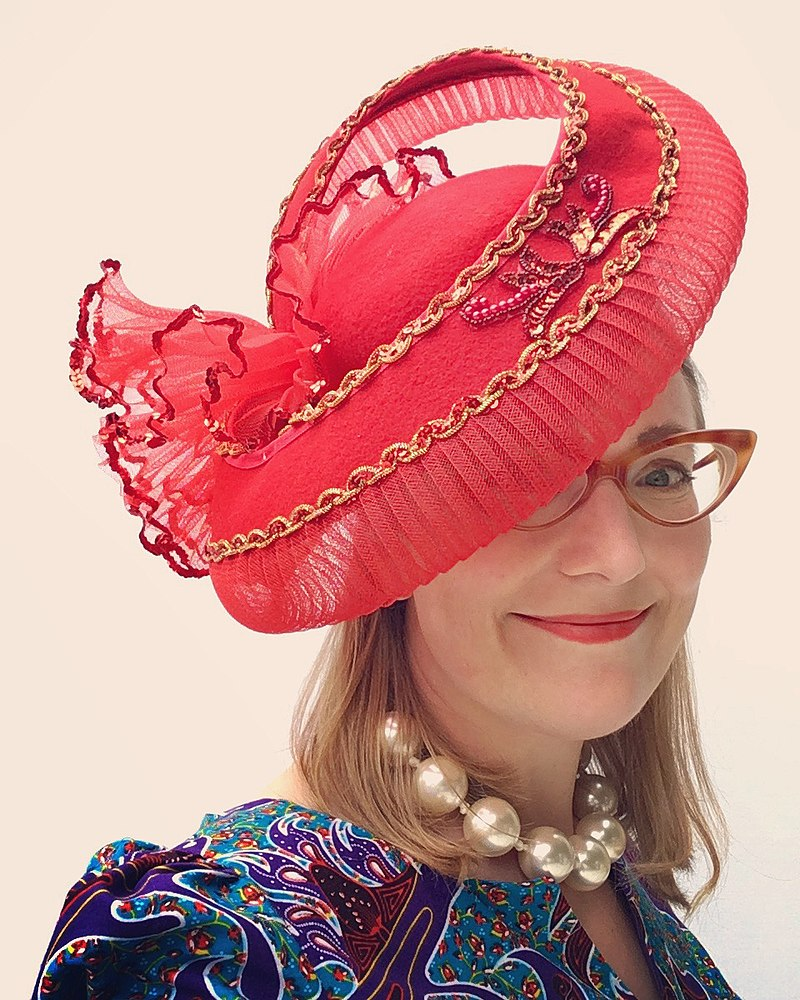Title of the work
Country of the First Edition
Country/countries of popularity
Original Language
First Edition Date
First Edition Details
Philip Reeve and Sarah McIntyre, The Legend of Kevin. Oxford: Oxford University Press, 2018, 158 pp.
ISBN
Genre
Illustrated works
Novels
Target Audience
Children (8–12)
Cover

We are still trying to obtain permission for posting the original cover.
Author of the Entry:
Elizabeth Hale, University of New England, ehale@une.edu.au
Peer-reviewer of the Entry:
Lisa Maurice, Bar-Ilan University, lisa.maurice@biu.ac.il
Elżbieta Olechowska, University of Warsaw, elzbieta.olechowska@gmail.com

Sarah McIntyre by Marmalade toast. Retrieved from Wikipedia, licensed under CC BY-SA 4.0 (accessed: January 26, 2022).
Sarah McIntyre (Illustrator)
Sarah McIntyre grew up in Seattle, Washington, and studied at Bryn Mawr College in Pennsylvania, graduating in 1999 with a degree in Russian literature. After graduating, she spent time in Russia, where she was inspired by the art, before moving to the United Kingdom to study for her Masters in Illustration at Camberwell College of Arts in 2007. She has written and illustrated several comics and picture books, including Grumpycorn, Don’t Call me Grumpycorn, There’s a Shark in the Bath, The New Neighbours. She collaborated with author Philip Reeve on several illustrated children’s books, including Oliver and the Seawigs, Thatch the Moon, Pugs of the Frozen North. She runs the Studio Teabreak twitter drawing challenges, and lives in the United Kingdom.
Sources:
Official website (accessed: September 16, 2020).
Profile at en.wikipedia.org (accessed: September 16, 2020).
Twitter (accessed: September 16, 2020).
Bio prepared by Elizabeth Hale, University of New England, ehale@une.edu.au

Retrieved from Wikipedia, public domain (accessed: December 30, 2021).
Philip Reeve
, b. 1966
(Author, Illustrator)
Philip Reeve was born on 28 February 1966 in Brighton. He studied illustration at Cambridgeshire College of Arts and Technology as well as at Brighton Polytechnic (now the University of Brighton). In his early professional life, he was occupied with writing comedy sketches and various no-budget theatre shows. He is an author and illustrator ofchildren's books. Due to lack of free time, he could no more work on film or theatre like he used to and turned to writing. As a result, he published his first novel entitled Mortal Engines (2001), currently being adapted for the screen by Peter Jackson. His other notable works are Here Lies Arthur, an alternative depiction of the Arthurian legend; the Larklight series in a steampunk setting; sequels to Mortal Engines, the Fever Crumb trilogy. In recent years Philip Reeve has been collaborating with Sarah McIntyre on illustrated books, the first of the series being Oliver and the Seawigs. Lives on Dartmoor with his family; loves writing, drawing, acting and history. Reeve has produced illustrations for many books including those in the Horrible Histories and Dead Famous series.
Sources:
Profile at the Wikipedia (accessed: June 25, 2018).
Profile at the www.mbalit.co.uk (accessed: February 10, 2017).
An interview about his books for children, is available on his publisher’s site (accessed: September 20, 2018)
Another interview, on the occasion of the release of Railhead (accessed September 20, 2018)
He answers questions about his writing preferences and process (accessed Semtember 20, 2018)
The Author’s Official Website
The Author’s Blog
Bio prepared by Agnieszka Maciejewska, University of Warsaw, agnieszka.maciejewska@student.uw.edu.pl and Joanna Bieńkowska, University of Warsaw, joanna.bienkowska@student.uw.edu.pl
Summary
A flying pony named Kevin, who has a sweet tooth and a round tummy, is blown away from his nest in the Outermost West, across the Outermost Sea, where the mermaids and cheeky sea monkeys live, and into the small town of Bumbleford. He crash-lands on the balcony of the top floor flat of a tall building, where a boy named Max lives with his mother, father and sister, Daisy (who wears black and likes the gloomy side of things). Max has always wanted an animal to look after. He brings Kevin into his bedroom, tends to his sprained wing, and at his request feeds him custard creams (Kevin can speak some English, and asks for biscuits and custard creams), avoiding Daisy, who is up enjoying the storm.
Overnight, the storm continues. The river bursts its banks, and the town of Bumbleford is flooded. Max’s mother’s hairdressing salon is flooded, along with the other buildings of the main street. Their neighbours from lower flats climb up the side of the building and take refuge in Max’s flat. After climbing on Kevin’s back and for a test-flight around his bedroom, Max sneaks the pony up onto the roof. More neighbours arrive. Max’s father discovers the custard creams are gone. Max puts on his swimming trunks and scuba mask, climbs on Kevin’s back and flies to the town hall, where he dives off the clock tower and swims to the supermarket. Surprisingly none of the citizens is shocked by the sight of a flying pony, because other magical creatures – mermaids and sea monkeys – have come to the town, swept along by the flood. In particular, the mermaids are enjoying giving themselves beauty treatments at Max’s mother’s salon.
Kevin waits for Max at the clock tower, trying out poses alongside the statues of lions on the roof. He sees Max, but also sees a shark fin moving towards him. He swoops down to save his friend, and discovers it belongs to a group of naughty sea-monkeys who are enjoying tricking people. Kevin dive-bombs them, scattering the monkeys, and rescuing Max. On their flight home, they encounter people in need of help, such as the head teacher Mr Mould, who is sitting on the roof of the school, surrounded by monkeys blowing raspberries. Max hurls frozen broccoli at them, and saves the teacher, who climbs on Kevin’s back.
They return to Max’s flat, which is becoming quite crowded, drop off the supplies, and then spend time ferrying other citizens of Bumbleford to the roof of the tall building. On their final trip, to rescue the mayor, the sea monkeys grab a tiring Kevin by the back hoof, anchoring the trio to the roof of the town hall. A helpful mermaid, however, passes Max a pot of pepper, which he empties over the monkeys, who sneeze and let go.
Everyone goes to sleep on the roof of Max’s apartment building, Max curled up next to Kevin. In the morning, they wake to find the floodwaters have abated. Despite the mess, the mermaids have left rare gold coins in the shop tills, which pay for the repairs. Max’s mother transforms her business into an underwater salon, with a pipe to the river so that mermaids can swim to it for haircuts. Max and Kevin enjoy helping clean up the town and spend time together, until the day the school reopens, and the friends are separated. Kevin begins to pine for his home. Max’s neighbour Gordon, who keeps pigeons, says "He’s a creature of the winds and the wild, wet hills. Maybe he doesn’t want to live in a town. Maybe it’s time you helped him find his way back to where he really belongs." (p. 144). Max and his family pile in the car and drive to the hills of the Outermost West, and help Kevin find his nest, then Max goes sadly home. But Kevin realises that home is where his Max is, and flies back to Bumbleford.
"He’d had a long think, and he had decided that now he knew his way from Bumbelford to the wild, wet hills he could always go back there when he felt like it, or when Max was busy at school. The rest of the time, he could live on Max’s roof. He had decided that home was wherever Max was. But he didn’t know enough words to explain all that to Max, so he just said, 'Custard creams?’" (p.156)
Analysis
Aimed at children aged 9–12 who are getting used to reading chapter books, The Legend of Kevin is a variation on a familiar trope in children’s literature, namely the "boy and his dog" or "girl and her pony" story, whereby a child shares adventures and finds friendship with an animal companion; it is also a variation on the trope in which a child becomes friends with a (sometimes troublesome) magical creature that adults cannot see. Max’s friendship with Kevin is played for laughs – Kevin, the roly-poly flying pony, is untidy and likes eating custard creams, and helps Max with a series of not particularly threatening comedy adventures. The emphasis of the story is on helping others and solving problems.
Kevin’s literary heritage of course traces back to the original flying steed, Pegasus: in this version, he may be a singular being, but we suspect there are more flying ponies in the world Reeve and McIntyre depict, which also features mermaids, themselves related to the original sirens of Greek myth. (According to Sarah McIntyre’s Jabberworks blog, accessed: September 16, 2020, the idea for Kevin came from a doodle that Philip Reeve had drawn of a square-ish flying pony; the collaborators drafted an idea called the Dartmoor Pegasus. The sea monkeys and mermaids feature in other of the pair’s work, such as Oliver and the Seawigs.) In The Legend of Kevin, these mythical creatures are benign and friendly, and integrate happily with humans, who are also accepting of their presence. When the adults of the town do encounter Kevin, they have already got used to the idea of magical beings by seeing the mermaids and sea monkeys. (Sea monkeys seem to draw their heritage from a type of quick-breeding brine shrimp, marketed through comics books, as a kind of aquarium pet. Their mischievous qualities are associated with monkeys more generally.)
The Legend of Kevin is gentle, happy story, illustrated with friendly cartoon images of Kevin, Max, and the people of Bumbleford, showing the warmth of a small town community rallying together in the face of a challenge from nature.


